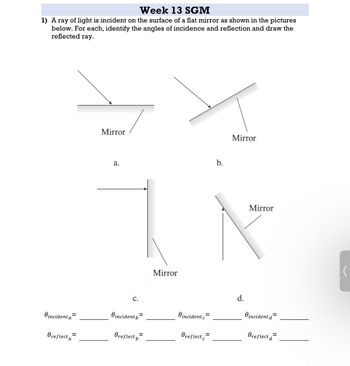
Principles of Physics: A Calculus-Based Text
5th Edition
ISBN: 9781133104261
Author: Raymond A. Serway, John W. Jewett
Publisher: Cengage Learning
expand_more
expand_more
format_list_bulleted
Question

Transcribed Image Text:Week 13 SGM
1) A ray of light is incident on the surface of a flat mirror as shown in the pictures
below. For each, identify the angles of incidence and reflection and draw the
reflected ray.
Mirror
a.
b.
C.
Mirror
Oincident a
Oincident b=
O incident c=
Oreflect a
=
Oreflect b
=
Oreflect=
Mirror
Mirror
d.
O incident d=
Oreflect d
=
Expert Solution
This question has been solved!
Explore an expertly crafted, step-by-step solution for a thorough understanding of key concepts.
This is a popular solution
Trending nowThis is a popular solution!
Step by stepSolved in 2 steps with 1 images

Knowledge Booster
Similar questions
- Unreasonable Results Suppose light travels from water to another substance, with an angle of incidence of 10.0° and an angle of refraction of 14.9°. (a) What is the index of refraction of the other substance? (b) What is unreasonable about this result? (c) Which assumptions are unreasonable or inconsistent?arrow_forwardA water fountain is at the center of a circular pool as shown in Figure P1.59. A student walks around the pool and measures its circumference C. Next, he stands at the edge of the pool and uses a protractor to measure the angle of elevation of his sightline to the top of the water jet. How high is the fountain?arrow_forwardA spherical mirror is to be used to form an image 5.00 times the size of an object on a screen located 5.00 m from the object, (a) Is the mirror required concave or convex? (b) What is the required radius of curvature of the mirror? (c) Where should the mirror be positioned relative to the object?arrow_forward
- An object 10.0 cm tall is placed at the zero mark of a meter-stick. A spherical mirror located at some point on the meter-stick creates an image of the object that is upright, 4.00 cm tall, and located at the 42.0-cm mark of the meterstick. (a) Is the mirror convex or concave? (b) Where is the mirror? (c) What is the mirror s focal length?arrow_forwardAstronomers often take photographs with the objective lens or mirror of a telescope alone, without an eyepiece. (a) Show that the image size h for such a telescope is given by h = fh/(f p), where f is the objective focal length, h is the object size, and p is the object distance. (b) What If? Simplify the expression in part (a) for the case in which the object distance is much greater than objective focal length. (c) The wingspan of the International Space Station is 108.6 m, the overall width of its solar panel configuration. When the station is orbiting at an altitude of 407 km, find the width of the image formed by a telescope objective of focal length 4.00 m.arrow_forward. A person looks at a statue that is 2 m tall. The image on the persons retina is inverted and 0.005 m high. What is the magnification?arrow_forward
- An underwater scuba diver sees the Sun at an apparent angle of 45.0 above the horizontal. What is the actual elevation angle of the Sun above the horizontal?arrow_forward(a) Does your bathroom mirror show you older or younger than your actual age? (b) Compute an order of magnitude estimate for the age difference, based on data you specify?arrow_forwardA lens is used to examine an object across a room. Is the lens probably being used as a simple magnifier? Explain in terms of focal length, the image, and magnification.arrow_forward
- What is the focal length of a pane of window glass? (a) zero (b) infinity (c) the thickness of the glass (d) impossible to determinearrow_forwardAn object is placed in front of a converging lens at an object distance of twice the focal length of the lens. Sketch a ray diagram and compare the image and object distances. Repeat with two more ray diagrams, using different focal lengths and still making the object distance twice the focal length. Can you draw any conclusions by comparing the object distance and the image distance?arrow_forwardA person spear fishing from a boat sees a stationary fish a few meters away in a direction about 30 below the horizontal. To spear the fish, and assuming the spear does not change direction when it enters the water, should the person (a) aim above where he sees the fish. (b) aim below the fish, or (c) aim precisely at the fish?arrow_forward
arrow_back_ios
SEE MORE QUESTIONS
arrow_forward_ios
Recommended textbooks for you
 Principles of Physics: A Calculus-Based TextPhysicsISBN:9781133104261Author:Raymond A. Serway, John W. JewettPublisher:Cengage Learning
Principles of Physics: A Calculus-Based TextPhysicsISBN:9781133104261Author:Raymond A. Serway, John W. JewettPublisher:Cengage Learning College PhysicsPhysicsISBN:9781938168000Author:Paul Peter Urone, Roger HinrichsPublisher:OpenStax College
College PhysicsPhysicsISBN:9781938168000Author:Paul Peter Urone, Roger HinrichsPublisher:OpenStax College Physics for Scientists and Engineers, Technology ...PhysicsISBN:9781305116399Author:Raymond A. Serway, John W. JewettPublisher:Cengage Learning
Physics for Scientists and Engineers, Technology ...PhysicsISBN:9781305116399Author:Raymond A. Serway, John W. JewettPublisher:Cengage Learning College PhysicsPhysicsISBN:9781285737027Author:Raymond A. Serway, Chris VuillePublisher:Cengage Learning
College PhysicsPhysicsISBN:9781285737027Author:Raymond A. Serway, Chris VuillePublisher:Cengage Learning College PhysicsPhysicsISBN:9781305952300Author:Raymond A. Serway, Chris VuillePublisher:Cengage Learning
College PhysicsPhysicsISBN:9781305952300Author:Raymond A. Serway, Chris VuillePublisher:Cengage Learning University Physics Volume 3PhysicsISBN:9781938168185Author:William Moebs, Jeff SannyPublisher:OpenStax
University Physics Volume 3PhysicsISBN:9781938168185Author:William Moebs, Jeff SannyPublisher:OpenStax

Principles of Physics: A Calculus-Based Text
Physics
ISBN:9781133104261
Author:Raymond A. Serway, John W. Jewett
Publisher:Cengage Learning

College Physics
Physics
ISBN:9781938168000
Author:Paul Peter Urone, Roger Hinrichs
Publisher:OpenStax College

Physics for Scientists and Engineers, Technology ...
Physics
ISBN:9781305116399
Author:Raymond A. Serway, John W. Jewett
Publisher:Cengage Learning

College Physics
Physics
ISBN:9781285737027
Author:Raymond A. Serway, Chris Vuille
Publisher:Cengage Learning

College Physics
Physics
ISBN:9781305952300
Author:Raymond A. Serway, Chris Vuille
Publisher:Cengage Learning

University Physics Volume 3
Physics
ISBN:9781938168185
Author:William Moebs, Jeff Sanny
Publisher:OpenStax